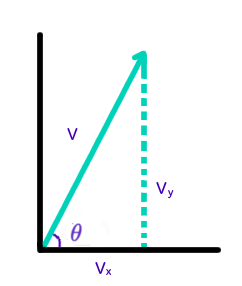Question #0e11f
1 Answer
See below.
Explanation:
Here is a basic diagram for the launch of a projectile, where

We can remember the most basic trig. functions for a right triangle by "SOH CAH TOA," where
#sin(theta)=y/r#
#cos(theta)=x/r#
#tan(theta)=y/x#
Where
If we wanted to find the vertical component of velocity,
#sin(theta)=(v_y)/v#
Solving for
#v_y=vsin(theta)#
If we wanted to find the vertical component of velocity,
#cos(theta)=(v_x)/v#
Solving for
#=>v_x=vcos(theta)#
If given the horizontal (vertical) component, we can find the vertical (horizontal) component using
#tan(theta)=(v_y)/(v_x)#
#v_y=v_xtan(theta)#
#v_x=(v_y)/(tantheta)#
These equations are only valid when the horizontal component is adjacent to the launch angle.
If you are dealing with a physics problem that puts your components in a different quadrant, you may have the horizontal component opposite the angle and the vertical component adjacent to the angle. If this is the case, simply flip the equations. For example, you would find the horizontal component using
#sin(theta)# and the vertical component using#cos(theta)# . In just above every basic projectile motion problem, however, you will find that the above equations hold.

